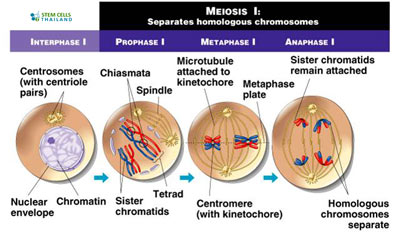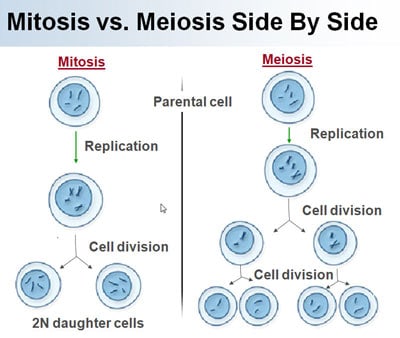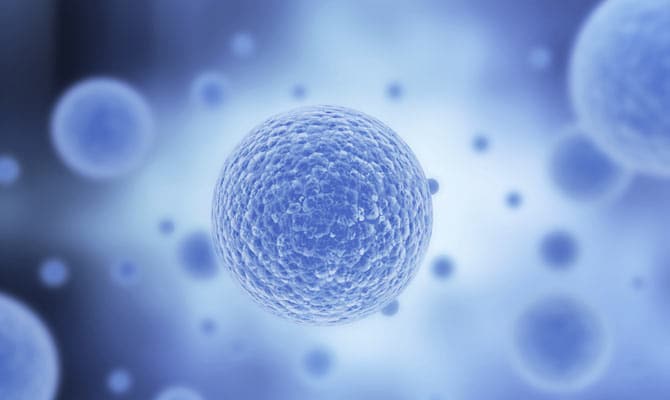The process of Cell meiosis occurs through cell division. In this Stage, the cells generate gametes (egg or sperm) and carry half of the normal chromosome count. After fertilization, the resulting embryo formation (after gamete) shall then finally contain the right number of chromosomes. Meiosis is a special type of cell differentiation that produces gametes with half as many chromosomes. Meiosis I is a type of cell division unique to germ cells, while meiosis II that is very similar to mitosis.[1]
eiosis is a specialized type of cell division that reduces the chromosome number by half, resulting in four non-identical daughter cells, each with half the number of chromosomes of the original cell. This process is critical for the formation of gametes (sperm and eggs) in sexually reproducing organisms. Meiosis ensures that offspring have the same chromosome number as their parents and introduces genetic variability.
Stages of meiosis – Meiosis I and Meiosis II:
- Meiosis I – Prophase I: Chromosomes condense and become visible.
- Homologous chromosomes (chromosomes that have the same genes but may have different alleles of those genes) pair up in a process called synapsis.
- Crossing-over can occur, where sections of chromatids from one chromosome exchange places with sections from its homologous partner. This introduces genetic variation.
- The nuclear envelope breaks down, and spindle fibers form.
- Metaphase I – Paired homologous chromosomes (tetrads) align at the cell’s equatorial plane.
Spindle fibers attach to the centromeres of each homologous chromosome. - Anaphase I – Homologous chromosomes are separated and pulled to opposite poles of the cell. Unlike mitosis, the sister chromatids remain attached.
- Telophase I – The separated chromosomes reach the poles and nuclear envelopes reform around them.
The cell then undergoes cytokinesis, splitting into two daughter cells, each with half the original chromosome number. - Meiosis II is similar to mitosis, but it involves the division of the two cells produced in Meiosis I.
- Prophase II – Chromosomes condense and become visible.
The nuclear envelope breaks down, and spindle fibers form in each of the two cells from Meiosis I. - Metaphase II – Chromosomes line up at the equatorial plane in both cells.
- Anaphase II – Sister chromatids are finally separated and move to opposite poles in both cells.
- Telophase II – Chromatids reach the poles, and nuclear envelopes reform.
Cytokinesis occurs, producing a total of four non-identical daughter cells, each with half the number of chromosomes of the original cell.
Meiosis introduces genetic variability through crossing-over and independent assortment of chromosomes. It ensures the stable transmission of genetic information by producing gametes that have half the chromosome number of somatic cells. When fertilization occurs, the diploid number of chromosomes is restored.
In humans, the result of meiosis is the formation of eggs (in females) and sperm (in males), both of which have 23 chromosomes, compared to the 46 chromosomes in somatic (body) cells. Learn more about genetic testing.
The First stage of Meiosis “I” reduces the ploidy levels from 2n to just n while the second stage of Meiosis “II” divides the last remaining set of chromosomes in a “mitosis-like” process.). The old name for meiosis was reduction/ division. Two daughter cells are formed during telophase I. These usually go immediately into the second cell division (meiosis II) to separate the chromatids.[2]

The steps involved in meiosis are similar to mitosis and even have the same names.Alleles are what help to facilitate this drive can also spread if they team up with the meiotic drive alleles. During the reduction division stage of meiosis I, cells go from a diploid to a haploid state.
What came first…the chicken or the egg?
The term “disjunction” describes the separation of the chromosomes in meiosis stage I or “sister” chromatids in meiosis stage II. NOTE** There is also an alternative theory about the origins of meiosis. This theory states that meiosis division evolved from mitosis. To better understand meiosis in eukaryotes, it’s very important to understand how meiosis can differentiate into a single cell eukaryotes. This is a vital function of the mitosis separation process. [3]

The mechanism by which meiosis occurs is the process to joining two genomes. That second division divides the number of chromosomes in half.
Published Clinical Citations
[1] ^ Gerton, J. L., & Hawley, R. S. Homologous chromosome interactions in meiosis: Diversity amidst conservation. Nature Reviews Genetics 6, 477–487 (2005) doi:10.1038/nrg1614
[2] ^ Lopez-Maury, L., Marguerat, S., & Bahler, J. Tuning gene expression to changing environments: From rapid responses to evolutionary adaptation. Nature Reviews Genetics 9, 583–593 (2008) doi:10.1038/nrg2398
[3] ^ Marston, A. L., & Amon, A. Meiosis: Cell-cycle controls shuffle and deal. Nature Reviews Molecular Cell Biology 5, 993–1008 (2004) doi:10.1038/nrm1526

